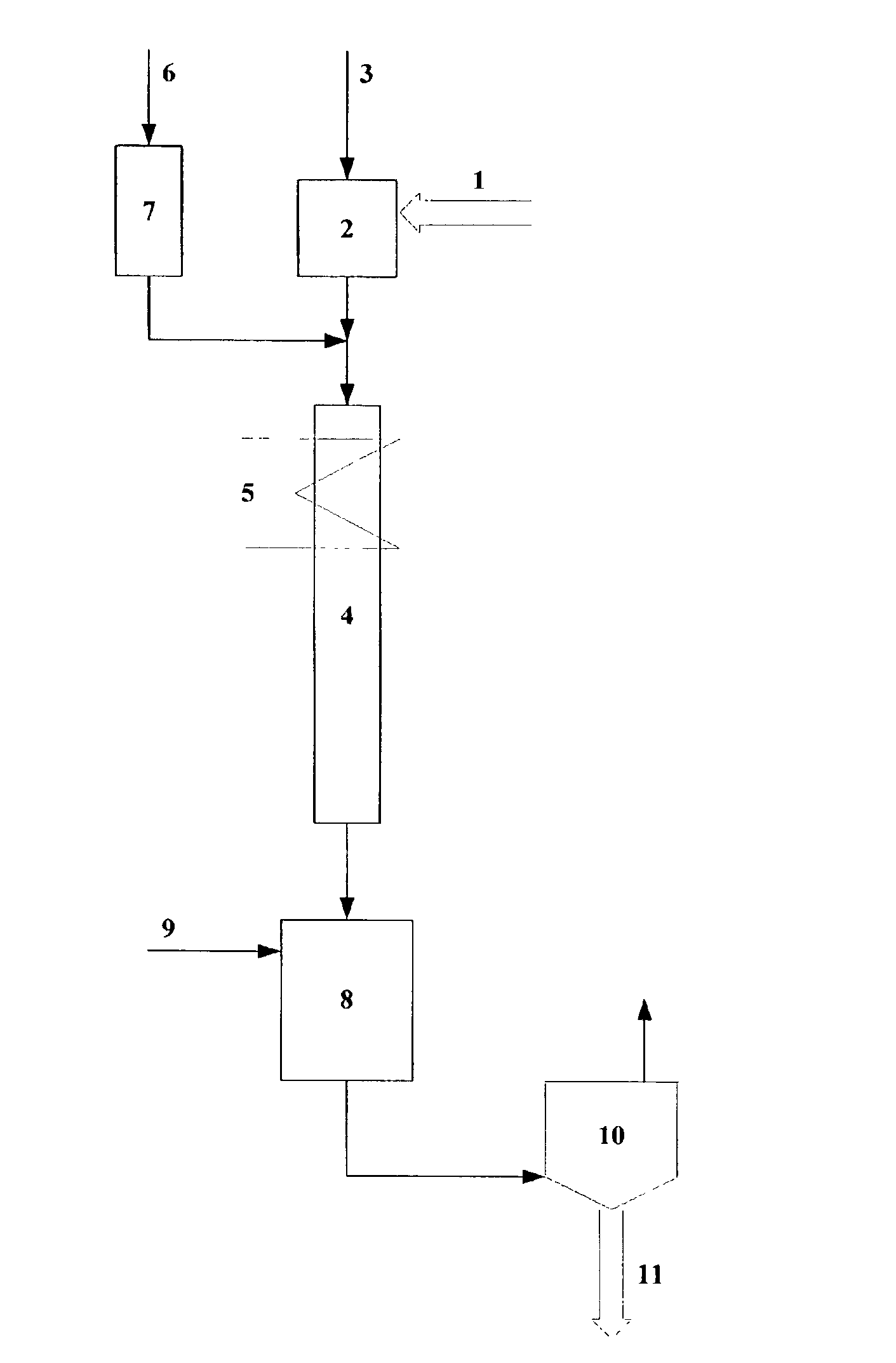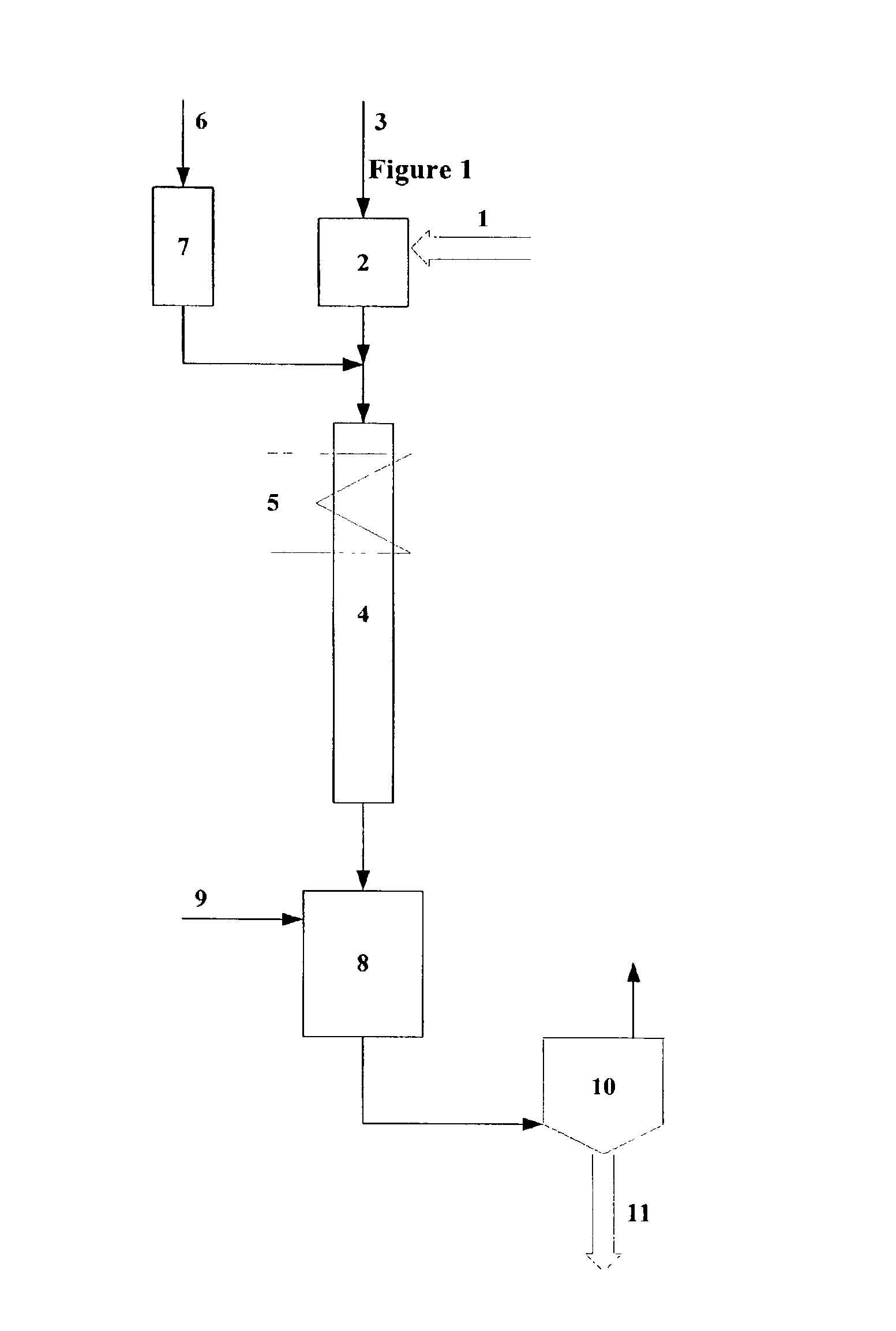Noble metal-containing supported catalyst and a process for its preparation
a technology of supporting catalyst and noble metal, which is applied in the direction of catalyst activation/preparation, metal/metal-oxide/metal-hydroxide catalyst, etc., can solve the problems of small particle size in itself, reducing catalytic activity, and not ensuring high activity
- Summary
- Abstract
- Description
- Claims
- Application Information
AI Technical Summary
Benefits of technology
Problems solved by technology
Method used
Image
Examples
example 1
Anode Catalyst for PEM Fuel Cells
Two kilograms of a carbon black supported electrocatalyst (noble metal loading 26.4 wt. % platinum and 13.6 wt. % ruthenium on Vulcan XC 72, atomic ratio Pt:Ru=1:1, prepared in accordance with U.S. Pat. No. 6,007,934) are metered into a gas disperser using a dosing balance and finely distributed with nitrogen as dispersing gas. The catalyst is then transported into the reaction tube in a stream of nitrogen preheated to 350° C.
Process parameters:
Carrier gas:nitrogenAmount of carrier gas:8 m3 / hour (nitrogen)Temperature (carrier gas): 350° C.Treatment temperature:1300° C.Treatment time:3 s (approx)Amount metered in:1100 g / hour
The treated catalyst is cooled with nitrogen in the rapid cooling unit and collected in the filter unit. A process control system is used to adjust the parameters and to monitor the same.
The catalyst treated in this way has the following properties:
Radiographic measurements (reflection hkl 111, 2 Theta ca. 40°):
Particle size (XRD):...
example 2
Pt / C Supported Catalyst for PEM Fuel Cells
One kilogram of a carbon black-supported electrocatalyst (platinum loading 40 wt. % on Vulcan XC 72) is metered into a gas disperser using a dosing balance and finely distributed with nitrogen as the injector gas stream. The catalyst is then transported into the reaction tube in a stream of nitrogen preheated to 350° C. Process parameters:
Carrier gas:nitrogenAmount of carrier gas:8 m3 / hour (nitrogen)Temperature (carrier gas): 350° C.Treatment temperature:1200° C.Treatment time:3 s (approx)Amount metered in:1000 g / hour
The treated catalyst is cooled with nitrogen in the rapid cooling unit and collected in the filter unit. A process control system is used to adjust the parameters and to monitor the same.
The catalyst treated in this way has the following properties:
Particle size (XRD):6.5nmLattice constant:0.3931nmIntensity (Ix, XRD):3000countsIntensity (Ia, XRD)400countsDegree of crystallinity Cx:6.5
For comparison the untreated starting materia...
example 3
PtCr / C Alloy Catalyst for PEM Fuel Cells
One kilogram of a carbon black-supported electrocatalyst (platinum content 40 wt. % on Vulcan XC 72, atomic ratio Pt:Cr=3:1) are metered into a gas disperser using a dosing balance and finely distributed with nitrogen as dispersing gas. The catalyst is then transported into the reaction tube in a stream of nitrogen preheated to 350° C.
Process parameters:
Carrier gas:nitrogenAmount of carrier gas:8 m3 / hour (nitrogen)Temperature (carrier gas): 350° C.Treatment temperature:1400° C.Treatment time:3 s (approx)Amount metered in:1000 g / hour
The treated catalyst is cooled with nitrogen in the rapid cooling unit and collected in the filter unit. A process control system is used to adjust the parameters and to monitor the same.
The catalyst treated in this way has the following properties:
Radiographic measurements (reflection hkl 111, 2 Theta ca. 40°):
Particle size (XRD):7.5nmLattice constant:0.385nmIntensity (Ix, XRD):3200countsIntensity (Ia, XRD)400count...
PUM
| Property | Measurement | Unit |
|---|---|---|
| particle size | aaaaa | aaaaa |
| particle sizes | aaaaa | aaaaa |
| particle sizes | aaaaa | aaaaa |
Abstract
Description
Claims
Application Information
 Login to View More
Login to View More - R&D
- Intellectual Property
- Life Sciences
- Materials
- Tech Scout
- Unparalleled Data Quality
- Higher Quality Content
- 60% Fewer Hallucinations
Browse by: Latest US Patents, China's latest patents, Technical Efficacy Thesaurus, Application Domain, Technology Topic, Popular Technical Reports.
© 2025 PatSnap. All rights reserved.Legal|Privacy policy|Modern Slavery Act Transparency Statement|Sitemap|About US| Contact US: help@patsnap.com



